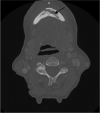Mandibular fractures in aged patients - Challenges in diagnosis
- PMID: 35950946
- PMCID: PMC9804783
- DOI: 10.1111/edt.12778
Mandibular fractures in aged patients - Challenges in diagnosis
Abstract
Background/aims: Delayed treatment of a mandibular fracture can lead to complications. Therefore, early diagnosis is important. The aim of this study was to clarify the specific features of mandibular fractures in aged patients and the effect of age on possible missed diagnoses.
Material and methods: Patients aged over 60 years with a recent mandibular fracture were included in the study. The outcome variable was a missed mandibular fracture during the patient's first assessment in the primary health care facility. Predictor variables were age group, categorized as older adults (aged ≥60 and <80 years), elders (aged >80 years), patient's age as a continuous variable and age sub-group divided into decades. Additional predictor variables were the patient's memory disease and injury associated with intracranial injury. Explanatory variables were gender, injury mechanism, type of mandibular facture, combined other facial fracture, edentulous mandible/maxilla/both, surgical treatment of the mandibular fracture, and scene of injury.
Results: Mandibular fractures were missed in 20.0% of the 135 patients during their first healthcare assessment. Significant associations between missed fractures and age group, gender, fracture type, or injury mechanism were not found. By contrast, memory disorder (p = .02) and site of injury (p = .02) were significantly associated with missed fractures. Fractures were missed more frequently in patients who were in hospital or in a nursing home at the time of injury.
Conclusions: There is an increased risk of undiagnosed mandibular fractures in the aged population. Small injury force accidents may cause fractures in old and fragile individuals. Careful examination is necessary, especially in patients with memory disorder.
Keywords: aged patient; geriatric patient; mandibular fracture; missed diagnose.
© 2022 The Authors. Dental Traumatology published by John Wiley & Sons Ltd.
Conflict of interest statement
The authors declare that they have no conflict of interest.
Figures



References
-
- Marchini L, Allareddy V. Epidemiology of facial fractures among older adults: a retrospective analysis of a nationwide emergency department database. Dent Traumatol. 2019;35:109–14. - PubMed
-
- Chrcanovic BR, Souza LN, Freire‐Maia B, Abreu MH. Facial fractures in the elderly: a retrospective study in a hospital in Belo Horizonte. Brazil J Trauma. 2010;69:E73–8. - PubMed
-
- Allard RH, Lekkas C. Unusual healing of a fracture of an atrophic mandible. Report of a case. Oral Surg Oral Med Oral Pathol. 1983;55:560–3. - PubMed
-
- Zachariades N, Papavassiliou D, Triantafyllou D, Vairaktaris E, Papademetriou I, Mezitis M, et al. Fractures of the facial skeleton in the edentulous patient. J Maxillofac Surg. 1984;12:262–6. - PubMed
-
- Lane NE. Epidemiology, etiology, and diagnosis of osteoporosis. Am J Obstet Gynecol. 2006;194:3–11. - PubMed

